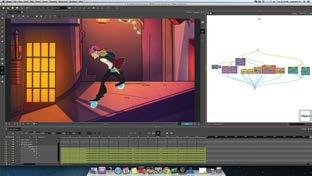
5 minute read
The Road Retraveled
Visual effects up the drama as the post-apocalypse gets even more dire in George Miller’s Mad Max: Fury Road. By Bill Desowitz.
George Miller, the originator of the dystopian genre, has craftily re-imagined Mad Max for the fourth time in Fury Road with Tom Hardy and Charlize Theron.
Max Rockatansky (Hardy) still wants to wander alone, but becomes swept up with a group fleeing across the Wasteland in a War Rig driven by an elite Imperator, Furiosa (Theron). Having opened May 15 from Warner Bros., Mad Max: Fury Road still contains a retro vibe, but Miller uses new camera rigs and well-placed VFX for a grittier thrill ride.
DP John Seale’s crew was outfitted with six Arri Alexas and a number of Canon 5Ds, with the latter used in part as crash cams in action sequences. They also used the Edge crane arm to get close to Furiosa’s War Rig.
“When I first talked to George about the film, he was very clear about wanting the randomness of the real world to play out,” says Andrew Jackson (300), the production visual-effects supervisor, based in Sydney. “That’s exactly what I like to do, because my background is in special effects and model-making. And my first thought is always, ‘How much of it can we shoot in live action?’ So it was wonderful working with George right from the start, because we’re both fans of that idea.”
Naturally, there was a lot of handheld action shot inside the War Rig, which is the main location throughout their journey. But the vehicle with the Edge crane was so effective that
they used it for both static and moving shots. “One of my jobs on set was always to remind people to keep everything moving because as soon as the vehicle stops, everything dies,” says Jackson. So it was important for the vehicle that the camera is mounted on to be rocked by the grips. And in post, that was one of the big lessons. Whenever one of the vehicles and “Because of the style of this film, a lot of the shots are less than one second long, so it’s really good to know what the cameras weren’t moving, they were some of the hardest they are. You don’t want to be adding 12-frame handles to a visual-effects shots 10-frame shot.” to make convincing.”
— Andrew Jackson, production visual-effects supervisor, Mad Max: Fury Road Post-vis Tightens It Up
One of the most important decisions, however, was the creation of a post-vis department at the production studio. “It was something that I knew would work very well, and I’ve done before, where we have a small team of 10 to 15 people doing a rough version
Iloura came up with the toxic storm sequence in Mad Max: Fury Road. The Australia-based visual-effects house used reference of tornadoes in creating the effect as a particle simulation in Houdini.

of all the visual effects,” Jackson says. “This team did basic tracking and roto, and my brief to that team was that they should essentially be bolted onto editorial and do whatever they need to help define the edit. And it’s a way of giving a director complete freedom to try out different ideas and turn out things quickly and cheaply. You have a watchable version of the film early on and can help it be much tighter before you turn it over to visual effects.”
A tighter film can save time and effort, Jackson says. “Because of the style of this film, a lot of the shots are less than one second long, so it’s really good to know what they are. You don’t want to be adding 12-frame handles to a 10-frame shot.”

Riding the Storm
The most prominent use of CG was the Toxic Storm, done by Iloura of Australia. It was a particle simulation done in Houdini. “It took a lot of work to make that look convincing and we referenced the biggest tornadoes that we could find that split up into multiple twisters. But it’s unlike any storm you’ve ever seen. We never did specify what the gasses were but whatever it was made of, this was not a good place to be.”
The Citadel is a group of three towers that’s the main location where the people of this world live. This provided Iloura with another VFX task: “We shot all of the action on the ground near the base of the towers in Sydney, but the rock walls themselves were a CG environment,” Jackson says. “We built them from a ridge just west of Sydney called The Blue Mountain. And there are huge cliffs there about 600 feet tall. We went out in a helicopter and flew very close and photographed high-resolution textures, and then, using photogrammetry software, we built 3D sections from those cliffs and then wrapped them into the shapes of the towers. It turned out to be very effective.”
Meanwhile, the post-vis team swapped over to finishing final shots as well and did a major section in a canyon where the War Rig pulls off. “A lot of the extension work in that part of the film was done by the post-vis team, which we called Fury Effects in the end,” Jackson says. “Although we went to an amazing canyon location, we still had to do a lot of work and there are a couple of shots where they blow up the side of the wall and dropped a lot of rocks to block the passage.”
Here again, Mad Max: Fury Road’s in the style of the original Mad Max — only the post-apocalypse is perhaps scarier in the 21st century.










